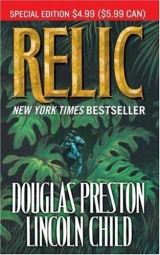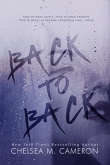
Текст книги "Relic"
Автор книги: Lincoln Child
Соавторы: Douglas Preston
Жанр:
Триллеры
сообщить о нарушении
Текущая страница: 10 (всего у книги 27 страниц)
= 23 =
D’Agosta looked over at Pendergast, reclining in the shabby backseat of the Buick. Jesus, he thought, a guy like Pendergast ought to pull at least a late model Town Car. Instead, they gave him a four-year-old Buick and a driver who could barely speak English.
Pendergast’s eyes were half closed.
“Turn on Eighty-sixth and take the Central Park transverse,” shouted D’Agosta.
The driver swerved across two lanes of Central Park West and roared into the transverse.
“Take Fifth to Sixty-fifth and go across,” said D’Agosta. “Then go one block north on Third and take a right at Sixty-sixth.”
“Fifty-nine faster,” said the driver, in a thick Middle Eastern accent.
“Not in the evening rush hour,” called D’Agosta. Christ, they couldn’t even find a driver who knew his way around the city.
[155] As the car swerved and rattled down the avenue, the driver flew on past Sixty-fifth Street.
“What the hell are you doing?” said D’Agosta. “You just missed Sixty-fifth.”
“Apology,” said the driver, turning down Sixty-first into a massive traffic jam.
“I can’t believe this,” D’Agosta said to Pendergast. “You ought to have this joker fired.”
Pendergast smiled, his eyes still half closed. “He was, shall we say, a gift of the New York office. But the delay will give us a chance to talk.” He settled back into the torn seat.
Pendergast had spent the last half of the afternoon at Jolley’s autopsy. D’Agosta had declined the invitation.
“This lab found several kinds of DNA in our sample,” Pendergast continued. “One was human, the other, from a gecko.”
D’Agosta looked at him. “Gecko? What’s a gecko?” he asked.
“A kind of lizard. Harmless enough. They like to sit on walls and bask in the sun. When I was a child, we rented a villa overlooking the Mediterranean one summer, and the walls were covered with them. At any rate, the results were so surprising to the lab technician that he thought it was a joke.”
He opened his briefcase. “Here’s the autopsy report on Jolley. There’s nothing much new, I’m afraid. Same MO, body horrifically mauled, thalamoid region of the brain removed. The coroner’s office has estimated that to create such deep lacerations in a single stroke, the required force would exceed—” he consulted a typewritten sheet “—twice what a strong human male can achieve. Needless to say, it’s an estimation.”
Pendergast turned some pages. “Also, they’ve now run salivase enzyme tests on brain sections from the older boy and from Jolley.”
“And—?”
[156] “Both brains tested positive for the presence of saliva.”
“Jesus. You mean the killer’s eatingthe fucking brain?”
“Not only eating, Lieutenant, but slobbering over the food as well. Clearly, he, she, or it has no manners. You have the SOC report? May I see it?”
D’Agosta handed it over. “You won’t find any surprises there. The blood on the painting was Jolley’s. They found traces of blood leading past the Secure Area and down into a stairwell to the subbasement. But last night’s rain flushed all traces out of there, of course.”
Pendergast scanned the document. “And here’s the report on the door to the vault. Someone did quite a lot of pounding and banging, possibly with a blunt instrument. There were also three-pronged scratches consistent with those found on the victims. Once again, the force used was considerable.”
Pendergast handed over the files. “It sounds as if we’ll need to devote more attention to the subbasement. Basically, Vincent, this DNA business is our best chance for now. If we can trace the origin of that claw fragment, we’ll have our first solid lead. That’s why I’ve asked for this meeting.”
The car pulled up in front of a warren of ivy-covered redbrick buildings overlooking the East River. A guard ushered them into a side entrance.
Once inside the lab, Pendergast took up a position against a table in the center of the room and chatted with the scientists, Buchholtz and Turow. D’Agosta admired how easily the Southerner could take charge of a scene.
“My colleague and I would like to understand the DNA sequencing process,” Pendergast was saying. “We need to know how you arrived at these results, and whether any further analysis might be called for. I’m sure you understand.”
“Certainly,” said Buchholtz. He was busy and small [157] and as bald as Mount Monadnock. “My assistant, Dr. Turow here, did the analysis.”
Turow stepped forward nervously. “When we were given the sample,” he said, “we were asked to identify whether it had come from a large carnivorous mammal. Specifically, a big cat. What we do in such a case is compare the DNA in the sample to the DNA of, say, five or six species that are likely matches. But we would also select an animal that was definitely notof the sample, and we call this the outgroup. It’s a kind of control. Am I making sense?”
“So far,” said Pendergast. “But go easy on me. I’ m a child in these matters.”
“We usually use human DNA as the outgroup, since we’ve mapped so much of it. Anyway, we do a PCR—that is, a Polymerase Chain Reaction—on the sample. This causes thousands and thousands of copies of the genes to be made. It gives us a lot to work with, you see.
He pointed to a large machine with long clear strips of Plexiglas attached to its flanks. Behind the strips were dark vertical bands arrayed in complicated patterns. “This is a pulsed-field gel electrophoresis machine. We place the sample in here, and portions of the sample migrate out along these strips through the gel, according to their molecular weights. They show up as these dark bands. By the pattern of bands, and with the aid of our computer, we can figure out what genes are present.”
He took a deep breath. “Anyway, we got a negative reading on the big cat genes. A verynegative reading. It wasn’t anywhere close. And to our surprise, we got a positivereading on the outgroup, that is, Homo sapiens. And, as you know, we identified DNA strands from several species of gecko—or so it appears.” He looked a little sheepish. “But even so, most of the genes in the sample were unidentified.”
“So that’s why you presumed it was contaminated.”
“Yes. Contaminated or degraded. A lot of repeated [158] base pairs in the sample suggested a high level of genetic damage.”
“Genetic damage?” asked Pendergast.
“When DNA is damaged or defective, it often uncontrollably replicates long repeating sequences of the same base pair. Viruses can damage DNA. So can radiation, certain chemicals, even cancer.”
Pendergast had begun to roam around the laboratory, examining his surroundings with an almost catlike curiosity. “These gecko genes interest me a great deal. Just what do they mean exactly?”
“That’s the big mystery,” said Turow. “These are rare genes. Some genes are very common, like the Cytochrome B gene, which can be found in everything from a periwinkle to man. But these gecko genes—well, we don’t know anything about them.”
“What you’re really saying is the DNA didn’tcome from an animal, right?” D’Agosta asked.
“Not from any large carnivorous mammal we know of,” Buchholtz answered. “We tested all the relevant taxa. There are not nearly enough matches to say it came from a gecko. So, by a process of elimination, I would say it probably came from a human. But it was degraded or contaminated. The results are ambiguous.”
“The sample,” said D’Agosta, “was found in the body of a murdered boy.”
“Ah!” said Turow. “That could easily explain how it was contaminated with human genetic material. Really, it would be much easier for us if we knew things like this beforehand.”
Pendergast frowned. “The sample was removed from the root canal of a claw by the forensic pathologist, as I understand it, and every effort was made to prevent contamination.”
“All it can take is one cell,” said Turow. “A claw, you say?” He thought a moment. “Let me advance an idea. The claw might be from a lizard that was heavily contaminated by blood from its human victim. Any [159] lizard—not necessarily a gecko.” He looked at Buchholtz. “The only reason we identified some of the DNA as gecko is because a fellow in Baton Rouge did some research a few years ago on gecko genetics, and logged his results in GenLab. Otherwise it would have turned up unknown, like most of that sample.”
Pendergast looked at Turow. “I’d like further tests done to tell us just what those gecko genes do, if you don’t mind.”
Turow frowned. “Mr. Pendergast, the chance of a successful analysis is not all that high, and it could take weeks. It seems to me the mystery’s already been solved—”
Buchholtz clapped his hand on Turow’s back. “Let’s not second-guess Agent Pendergast. After all, the police are paying for it, and it is a veryexpensive procedure.”
Pendergast smiled more broadly. “I’m glad you mentioned that, Dr. Buchholtz. Just send the bill to Director of Special Operations, FBI.” He wrote down the address on his business card. “And please don’t worry. Cost is no consideration whatsoever.”
D’Agosta had to grin. He knew what Pendergast was doing: getting even for the lousy car. He shook his head. What a devil.
= 24 =
Thursday
At eleven-fifteen Thursday morning, a man claiming to be the living incarnation of the Egyptian pharaoh Toth ran amok in the Antiquities wing, knocking over two displays in the Temple of Azar-Nar, breaking a case and pulling a mummy out of its tomb. Three policemen were necessary to restrain him, and several curators worked the rest of the day replacing bandages and collecting ancient dust.
Less than an hour later, a woman ran screaming from the Hall of Great Apes, babbling about something she’d seen crouched in a dark bathroom corner. A television team, waiting on the south steps for a glimpse of Wright, got her entire hysterical exit on film.
Around lunchtime, a group calling itself the Alliance Against Racism had begun picketing outside the Museum, calling for a boycott of the Superstitionexhibition.
Early that afternoon, Anthony McFarlane, a world-renowned philanthropist and big-game hunter, offered a reward of $500,000 for the capture and safe delivery of [161] the Museum Beast. The Museum immediately disclaimed any connection with McFarlane.
All of these events were duly reported in the press. The following incidents, however, went undisclosed to the world outside the Museum.
By noon, four employees had quit without notice. Thirty-five others had taken unscheduled vacations, nearly three hundred had called in sick.
Shortly after lunch, a junior preparator in the vertebrate paleontology department collapsed at her laboratory table. She was taken to Medical, where she demanded extended leave and worker’s compensation, citing severe emotional and physical stress.
By three P.M., security had responded to seven requests for investigations of suspicious noises in various remote sections of the museum. By curfew, police from the Museum command post had responded to four suspected sightings, all of which remained unverified.
Later, the Museum switchboard would tabulate the number of creature-related calls it received that day: 107, including crank messages, bomb threats, and offers of assistance from exterminators to spiritualists.
= 25 =
Smithback eased open the grimy door and peered inside. This, he thought, had to be one of the more macabre places in the Museum: the storage area of the Physical Anthropology Laboratory, or, in Museum parlance, the Skeleton Room. The Museum had one of the largest collections of skeletons in the country, second only to the Smithsonian—twelve thousand in this room alone. Most were North and South American Indian or African, collected in the nineteenth century, during the heyday of physical anthropology. Tiers of large metal drawers rose in ordered ranks to the ceiling; each drawer contained at least a portion of a human skeleton. Yellowed labels were slotted into the front of each drawer; on these labels were numbers, names of tribes, sometimes a short history. Other, briefer labels carried the chill of anonymity.
Smithback had once spent an afternoon wandering among the boxes, opening them and reading the notes, [163] almost all of which were written in faded, elegant scripts. He had jotted several down in his notebook:
Spec. No. 1880-1770
Walks in Cloud. Yankton Sioux. Killed in Battle of Medicine Bow Creek, 1880.
Spec. No. 1899-1206
Maggie Lost Horse. Northern Cheyenne.
Spec. No. 1933-43469
Anasazi. Canyon del Muerto. Thorpe-Carlson expedition, 1900.
Spec. No. 1912-695
Luo. Lake Victoria. Gift of Maj. Gen. Henry Throckmorton, Bart.
Spec. No. 1872-10
Aleut, provenance unknown.
It was a strange graveyard indeed.
Beyond the storage area lay the warren of rooms housing the Physical Anthropology Lab. In earlier days, physical anthropologists had spent most of their time in this laboratory measuring bones and trying to determine the relationship between the races, where humanity had originated, and similar studies. Now, much more complex biochemical and epidemiological research was being done in the Physical Anthro Lab.
Several years earlier, the Museum—at Frock’s insistence—had decided to merge its genetics research and DNA laboratories with the lab. Beyond the dusty bone-storage area lay a spotless assortment of huge centrifuges, hissing autoclaves, electrophoresis apparatus, glowing monitors, elaborate blown-glass distillation columns, and titration setups—one of the most advanced technical facilities of its kind. It was in the [164] no-man’s-land between the old and the new that Greg Kawakita had set up shop.
Smithback looked through the tall racks of the storage room toward the lab doors. It was just after ten, and Kawakita was the only one around. Through the open shelves, Smithback could see Kawakita standing one or two rows over, making sharp, jerky overhead movements with his left hand, waving something about. Then, Smithback heard the zing of a line and the whirring of a fly reel. Well, raise my rent, Smithback thought. The man was fishing.
“Catch anything?” he called out loudly.
He heard a sharp exclamation and a clatter of a dropped rod.
“Damn you, Smithback,” Kawakita said. “You’re always sneaking about. This isn’t a good time to go around scaring people, you know. I might have been packing a .45 or something.”
He walked down his aisle and came around the corner, reeling in his fly rod and scowling good-humoredly at Smithback.
Smithback laughed. “I told you not to work down here with all these skeletons. Now look what’s happened: you’ve gone off the deep end at last.”
“Just practicing,” Kawakita laughed. “Watch. Third shelf. Buffalo Hump.”
He flicked the rod. The line whirred out, and the fly struck, then rebounded off a drawer on the third tier of a shelf at the end of the aisle. Smithback walked over. Sure enough: it contained the bones of someone who had once been Buffalo Hump.
Smithback whistled.
Kawakita drew in some line, loosely holding the loops in his left hand while he gripped the cork butt of the rod in his right. “Fifth shelf, second row. John Mboya,” he said.
Again the line arced through the air between the narrow shelves and the tiny fly ticked the correct label.
[165] “Izaak Walton, move over,” said Smithback, shaking his head.
Kawakita reeled in the line and started dismantling the bamboo rod. “It’s not quite like fishing on a river,” he said as he worked, “but it’s great practice, especially in this confined space. Helps me relax during breaks. When I don’t tangle my line in one of the cases, that is.”
When Kawakita was first hired by the Museum, he had declined the sunny fifth-floor office offered him, and instead claimed a much smaller one in the lab, saying he wanted to be closer to the action. Since then, he had already published more papers than some full curators had in their entire careers. His cross-disciplinary studies under Frock had quickly led him to an Assistant Curatorship in evolutionary biology, where he had initially devoted his time to the study of plant evolution. Kawakita skillfully used his mentor’s notoriety to advance himself. Lately, he had put aside plant evolution temporarily for the Genetic Sequence Extrapolator program. His only other passion in life, aside from his work, seemed to be fly-fishing; in particular, as he would explain to anyone who listened, his search for the noble and elusive Atlantic salmon.
Kawakita slid the rod into a battered Orvis case and leaned it carefully in a corner. Motioning Smithback to follow, he led the way down long rows of confined aisles to a large desk and three heavy wooden chairs. The desk, Smithback noticed, was covered with papers, stacks of well-thumbed monographs, and low trays of plastic-covered sand holding various human bones.
“Look at this,” Kawakita said, sliding something in Smithback’s direction. It was an engraved illustration of a family tree, etched in brown ink on hand-marbled paper. The branches of the tree were labeled with various Latin words.
“Nice,” said Smithback, taking a seat.
“That’s one word for it, I guess,” Kawakita replied.
[166] “A mid-nineteenth century view of human evolution. An artistic masterpiece, but a scientific travesty. I’m working on a little piece for the Human Evolution Quarterlyabout early evolutionary views.”
“When will it be published?” Smithback asked with professional interest.
“Oh, early next year. These journals are so slow.”
Smithback put the chart down on the desk. “So what does all this have to do with your current work—the GRE, or the SAT, or whatever it is?”
“G.S.E., actually.” Kawakita laughed. “Nothing whatsoever. This is just a little idea I had, some after-hours fun. I still enjoy getting my hands dirty from time to time.” He replaced the chart carefully in a binder, then turned toward the writer. “So, how’s the masterwork coming along?” he asked. “Is Madame Rickman still giving you a hard time?”
Smithback laughed. “Guess my struggles under the tyrant are common knowledge by now. But that’s a book in itself. Actually, I came by to talk to you about Margo.”
Kawakita took a seat across from Smithback. “Margo Green? What about her?
Smithback started paging aimlessly through one of the monographs scattered about the worktable. “I understand she needs your help on something.”
Kawakita’s eyes narrowed. “She called last night, asking if she could run some data through the Extrapolation program. I told her it wasn’t ready yet.” He shrugged. “Technically, that’s true. I can’t vouch one hundred percent for the accuracy of its correlations. But I’m terribly busy these days, Bill. I just don’t have the time to shepherd somebody through the program.”
“She’s not exactly some scientific illiterate you need to lead around by the nose,” Smithback replied. “She’s doing some heavy-duty genetics research of her own. You must see her around this lab all the time.” He pushed the monographs aside and leaned forward. “It [167] might not hurt to cut the kid a break,” he said. “It isn’t exactly an easy time for her. Her father died about two weeks ago, you know.”
Kawakita looked surprised. “Really? Is that what you were talking about in the staff lounge?”
Smithback nodded. “She hasn’t said much, but it’s been a struggle. She’s considering leaving the Museum.”
“That would be a mistake,” Kawakita frowned. He started to say something, then stopped abruptly. He leaned back in his chair and gave Smithback a long, appraising look. “This is a mighty altruistic gesture on your part, Bill.” He pursed his lips, nodding slowly. “Bill Smithback, the good Samaritan. New image for you, eh?”
“That’s William Smithback Jr. to you.”
“Bill Smithback, the Eagle Scout,” Kawakita continued. Then he shook his head. “Nope, it just doesn’t ring true. You didn’t really come down here to talk about Margo, did you?”
Smithback hesitated. “Well, that was one of my reasons,” he admitted.
“I knew it!” Kawakita crowed. “Come on, out with it.”
“Oh, all right,” Smithback sighed. “Listen: I’m trying to get some information on the Whittlesey expedition.”
“The what?”
“The South American expedition that brought back the Mbwun figurine. You know, the showpiece for the new exhibition.”
Recognition flooded Kawakita’s face. “Oh, yes. That’s the one old man Smith must have been talking about in the herbarium the other day. What about it?”
“Well, we think there’s some kind of link between that expedition and these murders.”
“What?” Kawakita said incredulously. “Don’t tell [168] me you’restarting up with this Museum Beast stuff. And what do you mean, ‘we’?”
“I’m not saying I believe anything, okay?” Smithback replied evasively. “But I’ve been hearing a lot of strange stuff recently. And Rickman’s all tense about having the Mbwun figurine in the exhibition. Other things came back from that expedition besides this one relic—several crates, in fact. I want to find out more about them.”
“And what, exactly, do I have to do with all of this?” Kawakita asked.
“Nothing. But you’re an Assistant Curator. You have high-security access to the Museum computer. You can query the accession database, find out about those crates.”
“I doubt they’ve even been logged,” Kawakita said. “But either way, it wouldn’t matter.”
“Why not?” Smithback asked.
Kawakita laughed. “Wait here a minute.” He stood up and headed for the lab. In a few minutes he returned, a piece of paper in one hand.
“You must be psychic,” he said, handing over the paper. “Look what I found in my mail this morning.”
NEW YORK MUSEUM OF NATURAL HISTORY
INTERNAL MEMORANDUM
To: Curators and Senior Staff
From: Lavinia Rickman
CC: Wright, Lewallen, Cuthbert, Lafore
As a result of recent unfortunate events, the Museum is under intense scrutiny by the media and by the public in general. This being the case, I [169] wanted to take the opportunity to review the Museum’s policy on external communications.
Any dealings with the press are to be handled through the Museum’s public relations office. No comments on Museum matters are to be made, either on or off the record, to journalists or other members of the media. Any statements made or assistance given to individuals who are engaged in preparing interviews, documentaries, books, articles, etc. dealing with the Museum are to be cleared through this office. Failure to follow these guidelines will result in disciplinary action from the Director’s Office.
Thank you for your cooperation in this difficult time.
“Christ,” muttered Smithback. “Look at this. ‘Individuals engaged in preparing books.’ ”
“She means you, Bill,” Kawakita laughed. “So you ace? My hands are tied.” He extracted a handkerchief From his back pocket and blew his nose. “Allergic to bone dust,” he explained.
“I just can’t believe this,” Smithback said, rereading the memo.
Kawakita clapped an arm around Smithback’s shoulder “Bill, my friend, I know this story would make great copy. And I’d like to help you write the most controversial, outrageous, and salacious book possible. Only I can’t. I’ll be honest. I’ve got a career here, and—” he tightened his grip “—I’m coming up for tenure. I can’t afford to make those kinds of waves right now. You’ll have to go some other route. Okay?”
Smithback nodded with resignation. “Okay.”
“You look unconvinced,” Kawakita laughed. “But I’m glad you understand, anyway.” He gently propelled the writer to his feet. “I’ll tell you what. How about a [170] little fishing on Sunday? They’re predicting an early hatch on the Connetquot.”
Smithback finally grinned. “Tie me some of your devilish little nymphs,” he said. “You’re on.”








